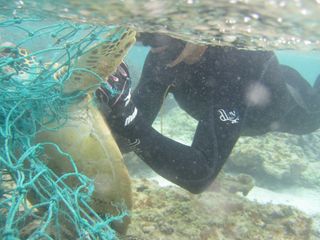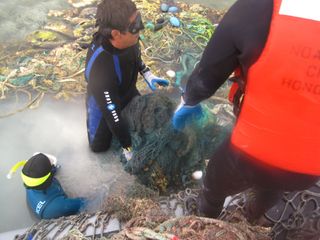50 Tons of Litter Pulled from Pacific

Scientists loaded their ship to the max this month off the coast of Hawaii, but their bounty wasn't fish or coral or any other scientific specimen. It was garbage.
The crew of the National Oceanic and Atmospheric Administration (NOAA) ship Oscar Elton Sette pulled 50 metric tons of marine debris out of the Papahanaumokuakea Marine National Monument off the northwestern Hawaiian Islands last month, part of an ongoing mission since 1996 to clean up the shallow coral reef environment.
"What surprises us is that after many years of marine debris removal in Papahanaumokuakea and more than 700 metric tons of debris later, we are still collecting a significant amount of derelict fishing gear from the shallow coral reefs and shorelines," Kyle Koyanagi, the chief scientist for the mission, said in a NOAA statement. "The ship was at maximum capacity and we did not have any space for more debris."
NOAA has been sending out garbage-removing ships every year since 1996. On the mission that ended Saturday (July 14), 17 scientists cleaned up the coastal waters and shorelines of the Kure Atoll, Midway Atoll, Pearl Atoll, Hermes Atoll, Lisianski Island and Laysan Island, all in the northern section of the Hawaiian Islands.

About half of the marine junk was broken fishing gear and plastic from Midway Atoll. Though the researchers looked, they found no evidence of debris from 2011's tsunami in Japan. Some debris from that disaster has shown up on the west coast of North America, including an enormous floating dock covered with marine organisms. [Images: Japanese Tsunami Dock]
Marine debris such as discarded nets can trap sea turtles, seals and other marine animals.
"[M]arine debris is an everyday problem, especially right here in the Pacific," Carey Morishige, the Pacific Islands regional coordinator for NOAA's Marine Debris Program said in a statement.
Sign up for the Live Science daily newsletter now
Get the world’s most fascinating discoveries delivered straight to your inbox.
The massive amount of garbage pulled from the ocean will now be put to use as fuel for electricity generation. Hawaii's Nets-to Energy program removes metal from broken-down nets and cuts them up for combustion. The steam from the fires runs a turbine to create energy.
Follow Stephanie Pappas on Twitter @sipappas or LiveScience @livescience. We're also on Facebook & Google+.

Stephanie Pappas is a contributing writer for Live Science, covering topics ranging from geoscience to archaeology to the human brain and behavior. She was previously a senior writer for Live Science but is now a freelancer based in Denver, Colorado, and regularly contributes to Scientific American and The Monitor, the monthly magazine of the American Psychological Association. Stephanie received a bachelor's degree in psychology from the University of South Carolina and a graduate certificate in science communication from the University of California, Santa Cruz.
Most Popular


